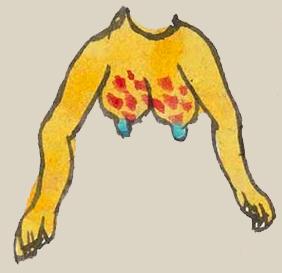chichihualli (Mdz15v)
This element has been carved from the compound glyph for the place name, Chichihualtatacala. The first component of this place name refers to chichihualli, or breasts, as pictured here. These are framed by two arms and an upper chest, with nothing more of the body or the head. The nipples are turquoise blue, and the breasts have red spots on them. The skin tone in this case is more yellow than orange or terracotta.
Stephanie Wood
This particular coloring is clearly not an attempt to be representative of natural nipple coloring. Thus, the turquoise color used for the nipples may be an allusion to their being the source of breast milk, a precious life-giving liquid akin to water, which is nearly always colored turquoise in the Codex Mendoza. The red spots on the chichihualli may represent scratch marks or blood, for the other principal element in the place name, tataca, is the verb to scratch. We have no further explanation for why the breasts are scratched. Slang for breasts today in Mexican Spanish is the apocopated "chichi," which works out in English to be akin to boobs or tits and can also mean female genetalia or buttocks, not to be confused with the word for dog (see below, right).
Stephanie Wood
c. 1541, but by 1553 at the latest
Stephanie Wood
breasts, nipples, pechos, senos, pezones

chichihual(li), breasts or teats, https://nahuatl.wired-humanities.org/content/chichihualli
breasts
el pecho o los senos
Stephanie Wood
Codex Mendoza, folio 15 verso, https://digital.bodleian.ox.ac.uk/objects/2fea788e-2aa2-4f08-b6d9-648c00..., image 41 of 188.
The Bodleian Libraries, University of Oxford, hold the original manuscript, the MS. Arch. Selden. A. 1. This image is published here under the UK Creative Commons, “Attribution-NonCommercial-ShareAlike 3.0 License” (CC-BY-NC-SA 3.0).


